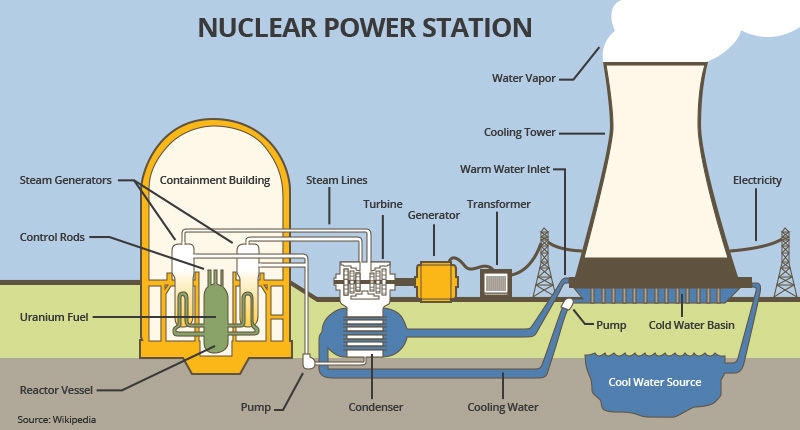Nuclear Energy
Safe, Reliable, Carbon-Free Energy
Benefits of Nuclear Energy
Providing Reliable Energy
Nuclear energy is a vital asset in the DTE Energy portfolio. In fact, our Fermi 2 facility accounts for 20 percent of the electricity we generate in Michigan, making it a trusted source of energy for businesses and homes.
Holding Down Consumer Energy Costs
Nuclear power is the lowest-cost producer of base-load electricity in the United States today, generating electricity for about 1.7 cents per kilowatt-hour. Fuel costs for Fermi 2 are about half those of the most efficient coal-fired plants. It is also the most reliable, with an average 90 percent capacity factor—the ratio of actual power generated vs. maximum possible.
Boosting State and Local Economies
Analysis shows that every dollar spent by the average nuclear plant results in the creation of $1.07 in the local community. Each year, the average nuclear plant generates approximately $430 million in sales of goods and services in the local community and nearly $40 million in total labor income. The average nuclear plant generates total state and local tax revenue of almost $20 million each year. These tax dollars benefit schools, roads and other state and local infrastructures.
Nuclear Energy Is Greenhouse Gas-Free Energy
Nuclear plants don't pollute the air. They don't produce any carbon dioxide—the major greenhouse gas. The relatively small amount of waste that a nuclear plant produces is carefully contained and safely stored.
Environmental Facts
- Nuclear power plants are the only large-scale power sources that do not emit any greenhouse gases. They also do not emit nitrogen oxides (NO, NO2 and N2O) or sulfur dioxide (SO2) gases.
- The only electricity sources with lower lifecycle emissions are wind and geothermal power.
- Nuclear energy accounts for 90 percent of all electric utility savings in carbon dioxide emissions since 1973.
- Water discharged from a nuclear power plant contains no harmful pollutants and meets regulatory standards for temperature designed to protect aquatic life.
- Nuclear power plants require less land area than all other energy sources, which aids conservation and wildlife efforts across the United States. In fact, many nuclear plants actually have wildlife sanctuaries onsite.
To learn more about DTE Energy’s environmental stewardship, visit the Environment section of our website or read our Corporate Citizenship Report.
How Nuclear Power Creates Electricity
A fossil-fueled plant burns fuel—such as coal, oil or gas—to create steam that spins a turbine to generate electricity. However, nuclear power plants split uranium atoms inside a reactor in a process called fission to produce steam that spins a turbine to generate electricity. Fission produces no carbon dioxide and one fuel pellet, roughly the size of a pencil eraser, equal to the amount produced by 4.5 barrels of oil, 17,000 cubic feet of natural gas or one ton of coal.

The Fuel
Uranium is a naturally occurring element abundant in the earth’s crust. Mined and extracted from other rock—most commonly uraninite or pitchblende—uranium is then enriched for use as nuclear fuel.
Uranium fuel arrives at Fermi 2 as small ceramic pellets, about the size of a pencil eraser. Each of these powerful pellets can produce the same amount of electricity as 4.5 barrels of oil, 17,000 cubic feet of natural gas or one ton of coal.
Inside the Reactor
Once these non-radioactive pellets have been thoroughly inspected to ensure their safe condition, they are stacked end-to-end in 12-foot long tubes or fuel assemblies. These fuel assemblies are precisely arranged in bundles within the reactor with spaces between for control rods.
The fuel assemblies are surrounded by water. Fission occurs when uranium atoms split, releasing neutrons. These neutrons collide with other atoms, splitting them. The splitting generates intense heat, which converts the water surrounding the fuel assemblies into steam, which is used to spin the turbine to create electricity. The control rods are moved in and out of the reactor between the fuel assemblies to start and stop the fission process.
Frequently Asked Questions
The electricity you use in your home is produced at a power plant, where fuel is used to boil water. The difference between a nuclear power plant and a fossil-fuel power plant is the heat source. Instead of burning coal, oil or gas, nuclear plants produce heat by splitting atoms. This process is called fission. Inside the reactor, pellets of uranium are stacked end-to-end in 12-foot long fuel rods. These rods are precisely arranged in bundles within the reactor with spaces between the bundles for control rods. The control rods can be moved in and out of the reactor to stop and start the fission process.
The heat generated in the fuel rods is transferred to water flowing through the reactor. As the water circulates, it begins to boil and turns into steam. This high-temperature steam travels through large steam lines at high pressure to the turbine. The force of the steam spins the turbine like a high-speed windmill, which spins the rotor of the electric generator.
In addition to information about DTE Energy’s Fermi 2 plant, information about nuclear energy can be found at the websites listed below.